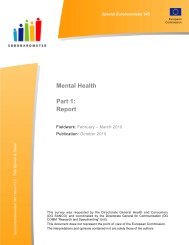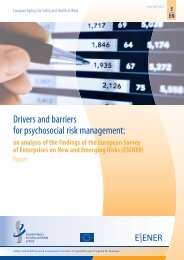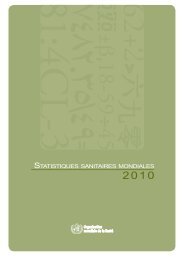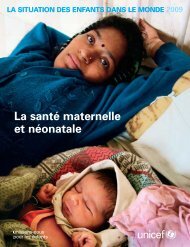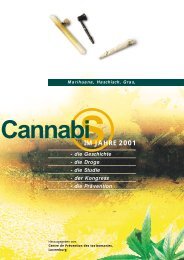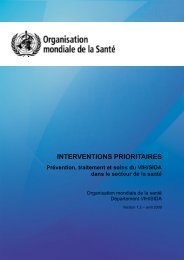Global Tuberculosis Control 2010 - Florida Department of Health
Global Tuberculosis Control 2010 - Florida Department of Health
Global Tuberculosis Control 2010 - Florida Department of Health
Create successful ePaper yourself
Turn your PDF publications into a flip-book with our unique Google optimized e-Paper software.
his annex explains the methods that were used to<br />
produce estimates <strong>of</strong> the global burden <strong>of</strong> disease<br />
caused by TB (measured in terms <strong>of</strong> incidence, prevalence<br />
and mortality). It has eight major sections:<br />
General approach. This section provides some background<br />
information about the methods used to produce<br />
estimates <strong>of</strong> disease burden.<br />
Definitions. This section defines TB incidence, prevalence<br />
and mortality and the case fatality rate. It also<br />
explains the regions for which estimates <strong>of</strong> disease<br />
burden are produced and sources <strong>of</strong> information on<br />
population estimates.<br />
Estimates <strong>of</strong> TB incidence, 1990–2009. This section<br />
explains the five main methods used to estimate TB<br />
incidence, and the countries for which they have been<br />
applied. It also discusses estimates <strong>of</strong> the incidence <strong>of</strong><br />
sputum smear-positive cases <strong>of</strong> pulmonary TB, and<br />
explains why such estimates (and related estimates <strong>of</strong><br />
the case detection rate for sputum smear-positive cases<br />
<strong>of</strong> pulmonary TB) are not included in this report.<br />
Estimates <strong>of</strong> HIV prevalence among incident TB<br />
cases, 1990–2009. This section explains the methods<br />
used to estimate the prevalence <strong>of</strong> HIV among<br />
incident cases <strong>of</strong> TB.<br />
Estimates <strong>of</strong> TB prevalence, 1990–2009. This section<br />
explains the two main methods used to estimate<br />
TB prevalence. These are national surveys <strong>of</strong> the prevalence<br />
<strong>of</strong> TB disease and indirect estimates based on<br />
combining estimates <strong>of</strong> incidence with estimates <strong>of</strong><br />
the duration <strong>of</strong> TB disease.<br />
Estimates <strong>of</strong> TB mortality, 1990–2009. This section<br />
explains the two methods used to estimate TB<br />
mortality. These are direct measurements from vital<br />
registration (VR) data and indirect estimates based<br />
on combining estimates <strong>of</strong> TB incidence with estimates<br />
<strong>of</strong> the case fatality rate. The countries for which<br />
these methods have been used are explained. Methods<br />
for estimating mortality by age and sex are also<br />
described.<br />
Projections <strong>of</strong> TB incidence, prevalence and<br />
mortality. This section explains how projections up<br />
to 2015 were produced.<br />
Uncertainty framework. This section explains the<br />
general approach to including uncertainty in all estimates.<br />
<br />
Estimates <strong>of</strong> the burden <strong>of</strong> disease caused by TB (measured<br />
in terms <strong>of</strong> incidence, prevalence and mortality) are<br />
produced annually by WHO using information gathered<br />
through surveillance systems (case notifications and<br />
death registrations), special studies (including surveys<br />
<strong>of</strong> the prevalence <strong>of</strong> disease and in-depth analyses <strong>of</strong><br />
surveillance data), expert opinion and consultations<br />
with countries. Two recent publications provide up-todate<br />
guidance about how TB incidence, prevalence and<br />
<br />
mortality should be measured, 1,2 based on the work <strong>of</strong><br />
the WHO <strong>Global</strong> Task Force on TB Impact Measurement.<br />
3 The methods used to estimate the burden <strong>of</strong> disease<br />
were updated in 2009 following 18 months <strong>of</strong> work<br />
by an expert group convened under the umbrella <strong>of</strong> the<br />
Task Force. Improvements to methods include systematic<br />
documentation <strong>of</strong> expert opinion and how this has<br />
been used to produce estimates <strong>of</strong> disease burden, simplification<br />
<strong>of</strong> models, 4 updates to parameter values based<br />
on the results <strong>of</strong> systematic reviews, much greater use <strong>of</strong><br />
mortality data from VR systems (89 countries instead <strong>of</strong><br />
the three from which estimates were derived up to 2008)<br />
and systematic documentation <strong>of</strong> uncertainty (hence<br />
the uncertainty intervals shown on all <strong>of</strong> the estimates<br />
<strong>of</strong> disease burden in this report).<br />
<br />
<br />
<br />
Incidence is defined as the number <strong>of</strong> new and relapse<br />
cases <strong>of</strong> TB (all forms) occurring in a given year. Relapse<br />
cases are defined as people who have been previously<br />
treated for TB and for whom there was bacteriological<br />
confirmation <strong>of</strong> cure and/or documentation that treatment<br />
was completed. Relapse cases may be true relapses<br />
or a subsequent episode <strong>of</strong> TB caused by reinfection.<br />
Prevalence is defined as the number <strong>of</strong> cases <strong>of</strong> TB disease<br />
(all forms) at a given point in time (the middle <strong>of</strong><br />
the year).<br />
Mortality is defined as the number <strong>of</strong> deaths caused by<br />
TB, excluding deaths occurring in HIV-positive TB cases,<br />
according to the definitions used in the 10th revision <strong>of</strong><br />
the International Classification <strong>of</strong> Diseases (ICD-10).<br />
Estimates <strong>of</strong> deaths caused by TB in HIV-positive cases<br />
are presented separately.<br />
The case fatality rate is defined as the risk <strong>of</strong> death<br />
from TB among people with active TB disease.<br />
<br />
Regional analyses are generally undertaken for the six<br />
WHO regions (that is, the African Region, the Region<br />
<strong>of</strong> the Americas, the Eastern Mediterranean Region,<br />
the European Region, the South-East Asia Region and<br />
1<br />
Dye C et al. Measuring tuberculosis burden, trends and the impact<br />
<strong>of</strong> control programmes. Lancet Infectious Diseases (published online<br />
16 January 2008; http://infection.thelancet.com).<br />
2<br />
TB impact ,measurement: policy and recommendations for how<br />
to assess the epidemiological burden <strong>of</strong> TB and the impact <strong>of</strong> TB<br />
control. Geneva, World <strong>Health</strong> Organization, 2009 (Stop TB policy<br />
paper no. 2; WHO/HTM/TB/2009.416). The policy paper is available<br />
on the Task Force’s website http://www.who.int/tb/advisory_<br />
bodies/impact_measurement_taskforce/en/index.html.<br />
3<br />
For further details, see the Task Force web site at: http://www.who.<br />
int/tb/advisory_bodies/impact_measurement_taskforce/en/index.<br />
html. The review is also the basis for the TB component <strong>of</strong> the update<br />
to the <strong>Global</strong> Burden <strong>of</strong> Disease, due for publication in <strong>2010</strong>.<br />
4<br />
For example, some parameter values are now estimated only at global<br />
level or for regions, rather than for each country individually.



